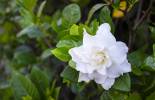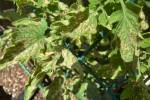High-nitrogen fertilizer keeps lawns green in winter
Don't forget the late fall fertilization of your lawn. An application of high-nitrogen fertilizer on a fescue lawn will help keep it green all winter long. If you miss this late fall application and cold weather comes in, then you run the risk of having it brown or discolor.
You can still plant for a few weeks yet. If you find some good bargains in the nursery, make sure you plant them with a good amount of compost. Make sure the compost is thoroughly mixed in with the soil you removed from the hole. Dig the hole as wide as possible, 10 times the width of the container.
Covering plants with mulch this time of the year helps keep the soil from cooling off too fast and favors root growth and establishment. Remember, fall planting gives you two seasons of good root growth: this fall and the following spring.
Q: I have a Carolina cherry laurel that is a little more than a year old. After last winter's freeze, the tree started to thin out slowly and now some of the leaves are yellow. The tree was lush and very green when it was planted. What can I do?
A: Carolina cherry laurels do not like rock mulch or very hot locations. So if the tree is in these locations, it may look OK for a few years and then decline. They like locations with some afternoon protection from the sun and they like organic soils.
Make sure the plant has lots of compost in the root area and cover the roots with organic mulch, such as wood mulch, that can decompose.
If you are using drip irrigation, you want enough emitters to wet the soil out to about 3 feet or 4 feet surrounding the trunk.
Water it as you would other ornamental and fruit trees that like frequent irrigations. Fertilize it next January with a good tree and shrub fertilizer high in nitrogen or use fertilizer stakes placed near the emitters.
Prune out any dead branches now, but if you have to prune heavily, do it next February.
You can do small pruning jobs any time. However, large jobs should be restricted to after leaf drop in the fall and before new growth in the spring. When you cut the tree back, decrease its size by cutting at crotches. Remove the larger or taller branch, leaving one remaining uncut, smaller branch.
Try to avoid "topping" or making the cuts and just leaving a stub or cut branch. When you walk away from the tree, it should be hard to see that it has been pruned.
Q: I think we have a brown turkey fig tree. The leaves fall and come back in the spring. The figs are very dry. What can we do to make the figs tasty and save them from the birds?
A: Most of that is probably related to not enough water or not being watered frequently enough. In other words, the soil is probably drying out too much between irrigations.
You can improve yield by making sure the tree is getting enough water and covering the soil with an organic mulch.
The tree is deciduous so it should drop its leaves in the fall. As far as bird damage, that will be a problem unless you net the tree.
Q: I have a few balconies that I would like to have citrus trees on. They have full southern exposure. Will they survive and thrive in large containers? What are the best varieties and tips for growing them?
A: Yes, they will work on balconies. Make sure the balconies can handle the weight of these containers. The containers must drain each time you water to help flush salts out from the soil.
I would focus on Meyer's lemon, mandarin orange, Satsuma orange, grapefruit and kumquat. Use moisture meters (available at nurseries) to help schedule irrigations. They cost about $8. Fertilize right after harvest and just after bloom times. Very little pruning is needed and they are not susceptible to many insects or diseases. The biggest problem on balconies might be wind.
Try not to use water from a water softener. But, if your water does come from a softener, use the potassium-based softening salts, not the sodium-based softener salts. It is more expensive but less damaging to plants.
Make sure to irrigate during morning hours before the heat of the day.
Bob Morris is an associate professor with the University of Nevada Cooperative Extension. Direct gardening questions to the master gardener hot line at 257-5555 or contact Morris by e-mail at extremehort@aol.com.























